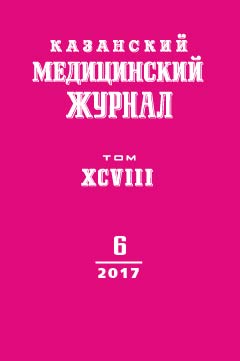Post-hypoxic reaction of astrocytes of the visual cortex in the experiment
- Authors: Drozdova GA1, Samigullina AF2, Nurgaleeva Y.A2, Bayburina GA2, Sorokin AA3
-
Affiliations:
- Peoples’ Friendship University of Russia
- Bashkir State Medical University
- Republican Cardiology Center
- Issue: Vol 98, No 6 (2017)
- Pages: 984-988
- Section: Biochemical aspects of pathological processes
- Submitted: 04.12.2017
- Published: 15.12.2017
- URL: https://kazanmedjournal.ru/kazanmedj/article/view/7254
- DOI: https://doi.org/10.17750/KMJ2017-984
- ID: 7254
Cite item
Full Text
Abstract
Keywords
About the authors
G A Drozdova
Peoples’ Friendship University of Russia
Email: saf-09@mail.ru
Moscow, Russia
A F Samigullina
Bashkir State Medical University
Email: saf-09@mail.ru
Ufa, Russia
Ye A Nurgaleeva
Bashkir State Medical University
Email: saf-09@mail.ru
Ufa, Russia
G A Bayburina
Bashkir State Medical University
Email: saf-09@mail.ru
Ufa, Russia
A A Sorokin
Republican Cardiology Center
Email: saf-09@mail.ru
Ufa, Russia
References
- Lundgaard I., Osorio M.J., Kress B.T. et al. White matter astrocytes in health and disease. Neuroscience. 2014; 276: 161-173. doi: 10.1016/j.neuroscience.2013.10.050.
- Gwag B.J., Won S.J., Kim D.Y. Excitotoxicity, oxidative stress, and apoptosis in ischemic neuronal death. In: New concepts in cerebral ischemia. N.Y. Washington: CRC PRESS. 2002; 88-121.
- Artal-Sanz M., Tavernarakis N. Proteolytic mechanisms in necrotic cell death and neurodegeneration. Protein. Peptides. 2005; 579 (15): 3287-3896. doi: 10.1016/j.febslet.2005.03.052.
- Горбунов А.В., Богомолова А.А., Хавронина К.В. «Глазные» симптомы как признаки повреждения головного мозга. Вестн. ТГУ. 2014; 19 (4): 1108-1110.
- Zhu H., Dahlstrom A. Glial fibrillary acidic protein-expressing cells in the neurogenic regions in normal and injured adult brains. J. Neurosci. Res. 2007; 85 (12): 2783-2792. doi: 10.1002/jnr.21257.
- Fried R. Enzymatic and non-enzymatic assay of superoxide dismutase. Biochemie. 1975; 57 (5): 657-660. PMID: 171001.
- Путилина Ф.Е. Определение содержания восстановленного глутатиона. Методы биохимических исследований. Л.: ЛГУ. 1982; 183-187.
- Sofroniew M.V. Molecular dissection of reactive astrogliosis and glial scar formation. Trends Neurosci. 2009; 3: 638-647. doi: 10.1016/j.tins.2009.08.002.
- Oberheim N.A., Takano T., Han X. et al. Uniquely hominid features of adult human astrocytes. J. Neurosci. 2009; 29 (10): 3276-3287. doi: 10.1523/JNEUROSCI.4707-08.2009.
- Sofroniew M.V. Molecular dissection of reactive astrogliosis and glial scar formation. Trends Neurosci. 2009; 32 (12): 638-647. doi: 10.1016/j.tins.2009.08.002.
- Pekny M., Nilsson M. Astrocyte activation and reactive gliosis. Glia. 2005; 50 (4): 427-434. doi: 10.1002/glia.20207.
- Sizonenko S.V., Camm E.J., Dayer A., Kiss J.Z. Glial responses to neonatal hypoxic-ischemic injury in the rate cerebral cortex. Int. J. Dec. Neurosci. 2008; 26 (1): 37-45. doi: 10.1016/j.ijdevneu.2007.08.014.
- Chen Y., Vartiainen N.E., Ying W. et al. Astrocytes protect neurons from nitric oxide toxicity by glutathione-dependent mechanism. J. Neurochem. 2001; 77: 1601-1610. PMID: 11413243.
Supplementary files







